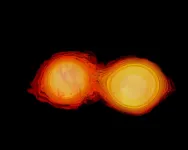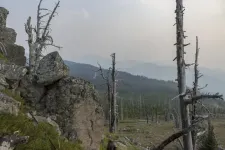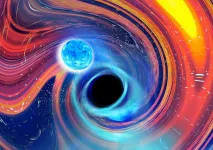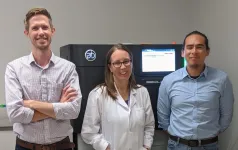(Press-News.org) Scientists have for the first time detected black holes eating neutron stars, "like Pac Man", in a discovery documenting the collision of the two most extreme and enigmatic objects in the Universe.
The Laser Interferometer Gravitational-Wave Observatory (LIGO) in the US and the Virgo gravitational-wave observatory in Italy have captured the gravitational waves from the death spiral and merger of a neutron star with a black hole, not once but twice. The findings are published today.
The researchers say their observations will help unlock some of the most complex mysteries of the Universe, including the building blocks of matter and the workings of space and time.
More than 1,000 scientists were involved with the world-first detections, with many from Australia, including The Australian National University, leading the way.
Distinguished Professor Susan Scott, a co-author on the study based at the ANU Research School of Physics in the Centre for Gravitational Astrophysics, said the events occurred about a billion years ago but were so massive that we are still able to observe their gravitational waves today.
"These collisions have shaken the Universe to its core and we've detected the ripples they have sent hurtling through the cosmos," she said.
"Each collision isn't just the coming together of two massive and dense objects. It's really like Pac-Man, with a black hole swallowing its companion neutron star whole.
"These are remarkable events and we have waited a very long time to witness them. So it's incredible to finally capture them."
One event included a black hole with a mass nine times bigger than our own sun and a neutron star with two times our sun's mass. The other event included a black hole with about six times the mass of our sun and a neutron star with 1.5 times its mass.
Professor Scott, also a Chief Investigator at the ARC Centre of Excellence for Gravitational Wave Discovery (OzGrav), said the international team had previously captured many events involving two black holes colliding as well as two neutron stars smashing together.
"Now, we've completed the last piece of the puzzle with the first confirmed observations of gravitational waves from a black hole and a neutron star colliding," she said.
Dr Johannes Eichholz, from the ANU Centre for Gravitational Astrophysics and an Associate Investigator with OzGrav, said the two detections were originally made on 5 and 15 January 2020.
"These kind of detections are incredibly rare," he said.
"We haven't detected these events once - but twice and within 10 days of each other.
"Like the ripples from these two events, which have been felt a billion years later, these findings will have a profound impact on our understanding of the Universe for many years to come."
INFORMATION:
The findings are published today in The Astrophysical Journal Letters.
FOR INTERVIEW:
Distinguished Professor Susan Scott
ANU Research School of Physics
M: +61 450 522 939
E: Susan.Scott@anu.edu.au
For media assistance, contact James Giggacher on +61 436 803 488 or ANU Media on +61 2 6125 7979 or media@anu.edu.au
Additional information about the gravitational-wave observatories
The ARC Centre of Excellence for Gravitational Wave Discovery (OzGrav) is funded by the Australian Government through the Australian Research Council Centres of Excellence funding scheme. OzGrav is a partnership between Swinburne University of Technology (host of OzGrav headquarters), The Australian National University, Monash University, University of Adelaide, University of Melbourne, and University of Western Australia, along with other collaborating organisations in Australia and overseas.
This material is based upon work supported by NSF's LIGO Laboratory which is a major facility fully funded by the National Science Foundation and operated by Caltech and MIT, which conceived of LIGO and led the Initial and Advanced LIGO projects. Financial support for the Advanced LIGO project was led by the NSF with Germany (Max Planck Society), the UK (Science and Technology Facilities Council) and Australia (Australian Research Council-OzGrav) making significant commitments and contributions to the project. Nearly 1300 scientists from around the world participate in the effort through the LIGO Scientific Collaboration, which includes the GEO Collaboration. A list of additional partners is available at https://my.ligo.org/census.php
The Virgo Collaboration is currently composed of approximately 700 members from 125 institutions in 15 different countries. The European Gravitational Observatory (EGO) hosts the Virgo detector near Pisa in Italy, and is funded by Centre National de la Recherche Scientifique (CNRS) in France, the Istituto Nazionale di Fisica Nucleare (INFN) in Italy, and Nikhef in the Netherlands. A list of the Virgo Collaboration members can be found at http://public.virgo-gw.eu/the-virgo-collaboration/
As smoky air becomes more common during Washington's wildfire season, many wildlife enthusiasts wonder: What happens to the birds?
Few studies have looked at wildfire smoke impacts on animals, let alone birds. And as Washington and the larger West Coast continue to experience more massive wildfires and smoke-filled air, understanding how birds are affected by smoke -- and how air pollution may influence our ability to detect birds -- are important factors for bird conservation.
Researchers from the University of Washington now provide a first look at the probability of observing common birds as air pollution worsens during wildfire seasons. They found that smoke affected the ability to detect more than a third of the bird species studied ...
For the first time, researchers have confirmed the detection of a collision between a black hole and a neutron star. In fact, the scientists detected not one but two such events occurring just 10 days apart in January 2020. The extreme events made splashes in space that sent gravitational waves rippling across at least 900 million light-years to reach Earth. In each case, the neutron star was likely swallowed whole by its black hole partner.
Gravitational waves are disturbances in the curvature of space-time created by massive objects in motion. During the five years since the waves were first measured, a finding that led to the END ...
A long time ago, in two galaxies about 900 million light-years away, two black holes each gobbled up their neutron star companions, triggering gravitational waves that finally hit Earth in January 2020.
Discovered by an international team of astrophysicists including Northwestern University researchers, two events -- detected just 10 days apart -- mark the first-ever detection of a black hole merging with a neutron star. The findings will enable researchers to draw the first conclusions about the origins of these rare binary systems and how often they merge.
"Gravitational ...
Gravitational wave detectors have observed a new type of cataclysmic event in the cosmos: the merger of a neutron star with a black hole.
The phenomenon was detected twice in January 2020.
Several hypotheses could explain the existence of such mixed pairs. Further observations will be needed in order to settle the question.
Another missing piece has just been added to our knowledge of cosmic phenomena. The LIGO, Virgo and KAGRA collaborations have announced the first detection of gravitational waves (1) resulting from the 'mixed' merger between a black hole and a neutron star (2). The discovery, published on June 29, 2021 in Astrophysical Journal Letters, involves CNRS researchers working within ...
LOUISVILLE, Ky. - Historically, most large-scale immunogenomic studies - those exploring the association between genes and disease - were conducted with a bias toward individuals of European ancestry. Corey T. Watson, Ph.D., assistant professor in the University of Louisville Department of Biochemistry and Molecular Genetics, is leading a call to actively diversify the genetic resources he and fellow immunogenomics researchers use in their work to advance genomic medicine more equitably.
Watson, along with UofL post-doctoral fellow Oscar Rodriguez, Ph.D., and visiting fellow Yana Safonova, Ph.D., are part of an international group of researchers ...
PHILADELPHIA -- (June 29, 2021) -- New biomarkers that predict HIV remission after antiretroviral therapy (ART) interruption are critical for the development of new therapeutic strategies that can achieve infection control without ART, a condition defined as functional cure. These biomarkers can also provide critical clues into the biological mechanisms that control HIV replication after stopping therapy, and can help design novel strategies to cure HIV. Scientists at The Wistar Institute have identified metabolic and glycomic signatures in the blood of a rare population of HIV-infected individuals who can naturally sustain viral suppression after ART cessation, known as post-treatment controllers. These findings were published in Nature ...
Scientists at the University of Sydney and Japan's National Institute for Material Science (NIMS) have discovered that an artificial network of nanowires can be tuned to respond in a brain-like way when electrically stimulated.
The international team, led by Joel Hochstetter with Professor Zdenka Kuncic and Professor Tomonobu Nakayama, found that by keeping the network of nanowires in a brain-like state "at the edge of chaos", it performed tasks at an optimal level.
This, they say, suggests the underlying nature of neural intelligence is physical, and their discovery opens an exciting avenue for the development of artificial intelligence.
The study is published today in Nature Communications.
"We used wires 10 micrometres long and no thicker than 500 nanometres ...
Researchers from Queen Mary University of London have identified a protein that could be used to aid in the diagnosis of pancreatic cancer.
Findings from the new study suggest that a protein called pentraxin 3 (PTX3) may be a specific diagnostic biomarker - or biological measure - for pancreatic cancer, with the ability to differentiate pancreatic cancer from other non-cancerous conditions of the pancreas.
The research was published today in npj Precision Oncology, and primarily funded by the Pancreatic Cancer Research Fund, Barts Charity and Cancer Research UK.
PTX3 levels elevated in patients with pancreatic ...
This press release is in support of a presentation by Dr Maria Cerrillo Martinez presented online at the 37th Annual Meeting of ESHRE.
29 June 2021: Fertility patients who have a poor response to ovarian stimulation represent a stubborn challenge in IVF. Few eggs are collected, success rates are low, and several treatments are usually needed to achieve pregnancy (if at all). Clinical guidelines indicate that increasing the drug dose for stimulation or applying any of several adjunct therapies are of little benefit. Now, however, a study assessing two cycles of ovarian stimulation and two egg collections in the same menstrual cycle may yet provide ...
This press release is in support of a presentation by Dr Gulam Bahadur presented online at the 37th Annual Meeting of ESHRE.
29 June 2020: Studies indicate that the optimal and safe number of oocytes needed for achieving an ongoing pregnancy is between six and 15. However, the use of egg freezing, frozen embryo replacement (FER) cycles and aggressive stimulation regimes has increased this number in order to boost success rates in older women and in poor responders who produce fewer eggs. What is not known is the impact of numbers of eggs retrieved and of over-stimulation practices on the health of patients, and on their emotional and financial well-being.
Now, a retrospective observational ...





